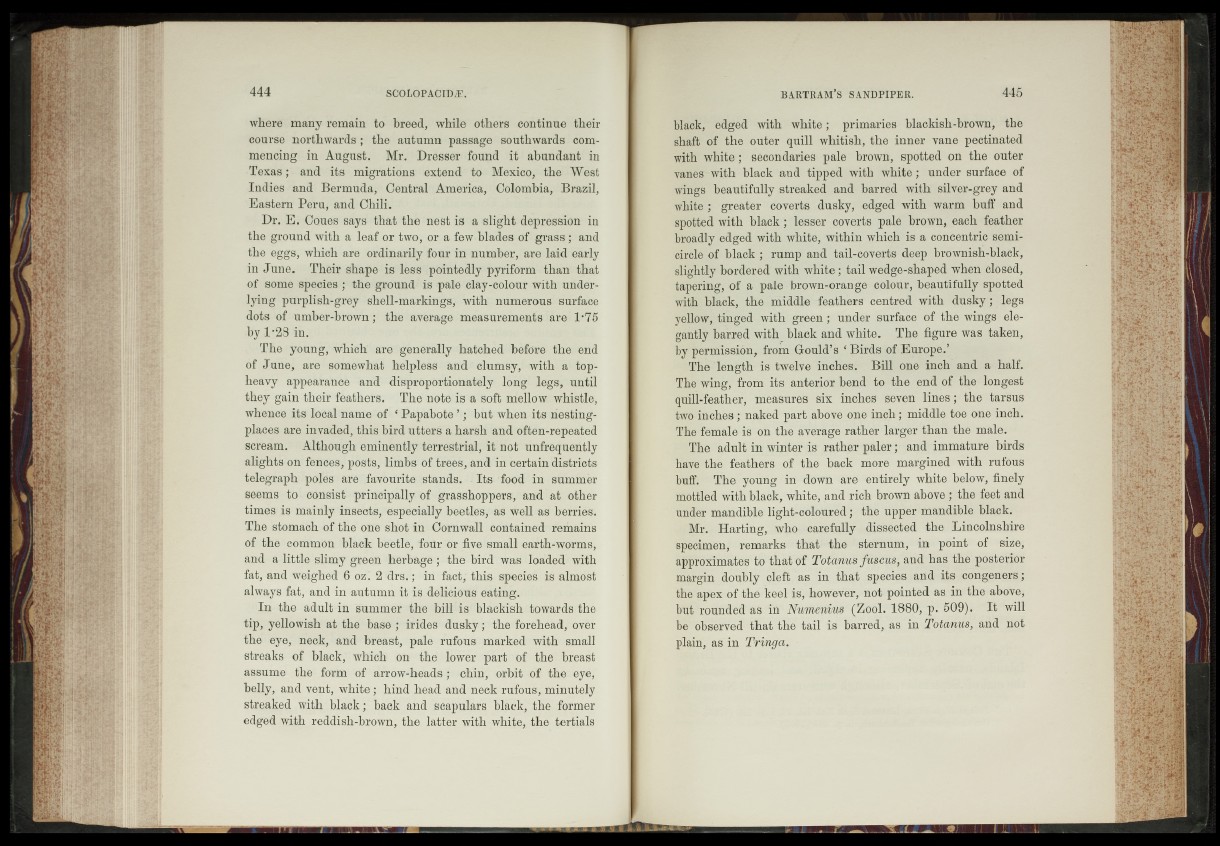
where many remain to breed, while others continue their
course northwards; the autumn passage southwards commencing
in August. Mr. Dresser found it abundant in
Texas; and its migrations extend to Mexico, the West
Indies and Bermuda, Central America, Colombia, Brazil,
Eastern Peru, and Chili. "
Dr. E, Coues says that the'nest is a slight depression in
the ground with a leaf or two, or a few blades of grass; and
the eggs, which are ordinarily four in number, are laid early
in June. Their shape is less .pointedly pyriform than that
of some species ; the ground; is -pale clay-COlour .with underlying
purplish-grey shell-markings, with numerous surface
dots of umber-brown; the average measurements arell>75
by 1*28 in.
The yoting, which are generally hatched before the end
of June, arc somewhat helpless and clumsy, with a top-
heavy appearance and disproportionately- long- legs, until
they gain their feathers. The note*is a soft; SrfeHoWwMstfe,
whence its local name of ‘ Papabote ’, but when its nesting-
places are invaded, this bird uttersa harsh and often-repeated
scream. Although eminently terrestrial, it riot'lanfrequehtly
alights on fbhees,'posts, limbs of trees, and in certain districts
telegraph poles are favourite stands. * Its-food in summer
seemso to - consist principally ofe grasshoppers,-’ and at; other
times is mainly insects, especially beetles, aS well ;aS berries.
The stomach of the one shot in Cornwall contained remains
of -the'scOrOfaron black beetle, four or five small earth-worms,
and a little slimy green herbage; tbe bird was loaded with
fat, and weighed 6 oz! 2'drg^; f n fact,- this species is almost
alway-pfatj- and in ^autumn it is delicious eating.
In the adult in summer -the billHs> blackish towards-the
tip, yellowish at the base ; hides' dusky; the forehead, over
the eye, neck, and breast, pale rufous marked with small
streaks'of black,”which On the£€&&@r- -part->of 4he’ breast
assume the-form of arrow-heads; chin, orbit of the icyatj
belly, and vent, white; hind head and neck rufous, minutely
streaked, with, black ; back and scapulars blfeck' A^- former
edgCd with reddish-brown, the latter with-white, the tertials
black, edged with white; primaries blackish-brown, the
shaft of the outer quill whitish, the inner vane pectinated
with white; secondaries pale brown, spotted on the outer
vanes1'with black and tipped with white; under surface of
wings beautifully streaked and barred with silver-grey and
white; greater coverts dusky, edged with warm buff and
spotted with black; lesser coverts pale brown, each feather
broadly edged with white, within whichfe a concentric semicircle,
of black ; rump and tail-coverts deep brownish-black,
slightly bordered with whitewall;wedge-shaped whenyClosed,
tapering, of a pale brown-orange colour, beautifully spotted
with black, the middle -feathers centred with- dusky; legs
yellow, tinged with green; ppder surface of the wingsfyeTe-
gantly barred with black and white.- The figure Was taken,
by,fpermissi-on, from Gould’s | Birds of Europe.’
The length- is twelve inches:'- Bill one inch' and a half.
The wing, from its, anterior bend; to-the end of the longest
quill-feather, measures-'six inches seven lines; the tarsus
twb-inches; naked part .above one inch; middle toe- one inch.
The female is^on the average rather larger than the male. *
•^Tho adult in winter is* rather paler ;• and- immature birds
have 'fee feathers of the back more margined with rufous
buff. The young in down are entirely white below, finely
mottled with black, white-, and yich brown above ; the feet and
under mandible light-coloured1’; the upper-mandible black.
Mr.- Karting,, who carefully dissected the- Lincolnshire
specimen, remarks that the- sternum, in-- point of size,
approximates to- that of Tbtayiu'i j%scUs\ and has the posterior
margin |t6ubl^.c|^ft{1as in .that jj species arid its congeners;
the apex of -the? k@cM#, -however, not pointed as in? the above;
but rounded as in Nuffiefiius £Zool. 1880, p. IBflH It will
Be" observed that the tail is barred, as in !Totaiius, and ng|
plain, in: ^ringa. ■